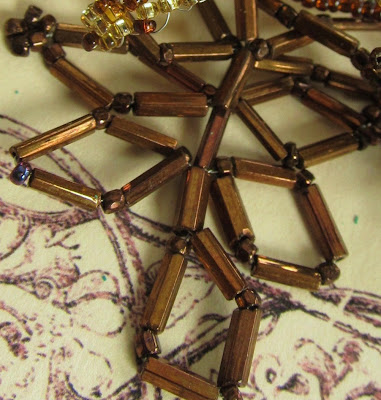I just realized I failed to give any information on the beading techniques I used in my final 2010 swatch - oops!
 The leaves are passed an an article form Godey's Magazine and Lady's book, circa 1854.
The leaves are passed an an article form Godey's Magazine and Lady's book, circa 1854.
This particular article is somewhat unusual, as the directions are actually useful!
Most often, instructions of this era are "Make up in the usual manner" or "Any lady can complete this...by examining our illustration".

The flowers and the dragonfly are made using a technique called Victorian beading.
Victorian beading is often confused with French beading, as both use wire and are frequently used for flowers, but the two techniques are quite different.
Victorian beading is made similar to ladder stitch Is is made with horizontal lines of beads and both ends of the wire go through the whole row. There are more or less beads added to each row, to create the shape of the petal or leaf.

With French Beading all the beads are thread onto the wire before beginning, and the wire is left on the spool and not cut till the end. Rows of beads that are twisted onto a separate section of wire at the top, then the row of beads is passed down the other side, and to another section at the bottom, where it is twisted around again and then goes back to the top until the desired shape is formed.
Completed French beading is typically fairly heavy weight, as a large wire needs to be used; Victorian beading can use a much smaller wire, actually you must use light weight wire as it needs to pass through each bead twice.
I've never seen a vintage example of French beading used for personal adornment, only for decorative home items - thus my choice of Victorian beading for my swatch.

















 Elegant ladies have always known the value of flowers as adornment and fresh are not always possible.
Elegant ladies have always known the value of flowers as adornment and fresh are not always possible.

 I designed a display card to mount this on, with a botanical theme - the "Fantasy Dressmaker" is well aware that presentation makes all the difference!
I designed a display card to mount this on, with a botanical theme - the "Fantasy Dressmaker" is well aware that presentation makes all the difference!



 Breaking ice is noisy...
Breaking ice is noisy...

 The "Fantasy Dressmaker" experimented with an ancient technique this month, netting.
The "Fantasy Dressmaker" experimented with an ancient technique this month, netting.



 The little stems, which once held flowers and then seeds, seem almost designed to capture and hold the snow.
The little stems, which once held flowers and then seeds, seem almost designed to capture and hold the snow. A trail through the cedars.
A trail through the cedars. And "ye old blockhouse", heading down Fort Hill.
And "ye old blockhouse", heading down Fort Hill.





 The bezel includes freshwater pearls and faceted copper beads.
The bezel includes freshwater pearls and faceted copper beads. 

 These buttons are, of course, beaded, using a needlepoint technique. The motif is pansies or heartease. In the Victorian language of flowers, they represent loving thoughts or memories.
These buttons are, of course, beaded, using a needlepoint technique. The motif is pansies or heartease. In the Victorian language of flowers, they represent loving thoughts or memories. 






